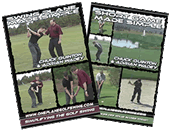by Chuck Quinton
Golf Biomechanics - Boost Stability and Power with the "Anchor" |
Rotary Swing Golf |
by Chuck Quinton
![]() View
"The Anchor - Creating Vertical Ground Force" Video
View
"The Anchor - Creating Vertical Ground Force" Video
An all too common swing fault for millions of golfers is to come out of their posture, or lose their spine angle, during the downswing. This "early extension" is something that not only robs the golfer of control and power, but places the golfer at potential risk for injury in the lead hip and lumber spine (low back). Unfortunately, most golfers and even instructors don't understand the biomechanical causes of this common fault, or how to fix it. To first understand how to fix it, let's first look at what it looks like when done correctly from a unique angle.
In the photo sequence below is footage of Tiger Woods hitting a three wood. The image on the left is Tiger after he has already started the club back down during the downswing. Of imporant note here is that BOTH knees are still flexed significantly. In the second photo we can see that Tiger's belt has moved up significantly above where it was during the transition (indicated by the yellow line), almost in a jumping fashion, all the while, maintaining the flex in his right knee. For most amateurs, they never load their gluteus (butt) muscles during the downswing as Tiger has by "squatting" during the transition, which is a tremendous source of power and stability. In fact, many golfer straighten the right leg completely before they finish their backswing. If they do maintain the proper knee flex they start pushing off their right foot in the downswing to spin their hips around as fast as possible, leaving the club and arms stuck behind the body and causing them to lose their spine angle.
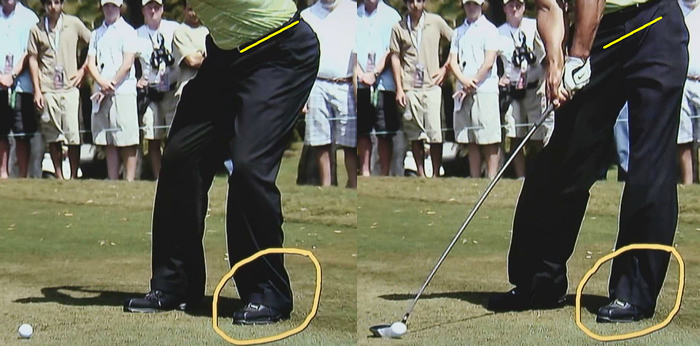
Let's take a closer look at what happened during the first image with Woods above from the down the line view. Below, you can see that both Tiger on the right and me on the left have the look of "squatting" during the transition and have maintained or slightly increased our knee flex that we had a the top of the swing. From a biomechanics standpoint this is critical to be able to load the gluteus muscle for power and stability. If you straighten up during this phase, it causes an "over the top" move so common to amateurs and saps all the power from the powerful trunk muscles.
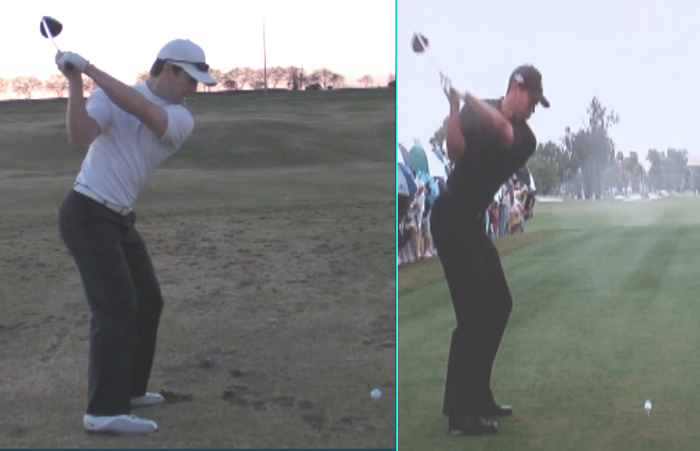
If we look at the top of the swing positions below, we can see that there is about 162 degrees of knee flex at the top of the backswing. Maintaining this knee flex is the most powerful way that you can activate the right glute at this point in the swing to be able to use the ground for leverage during the downswing, or create Vertical Ground Force (VGF).
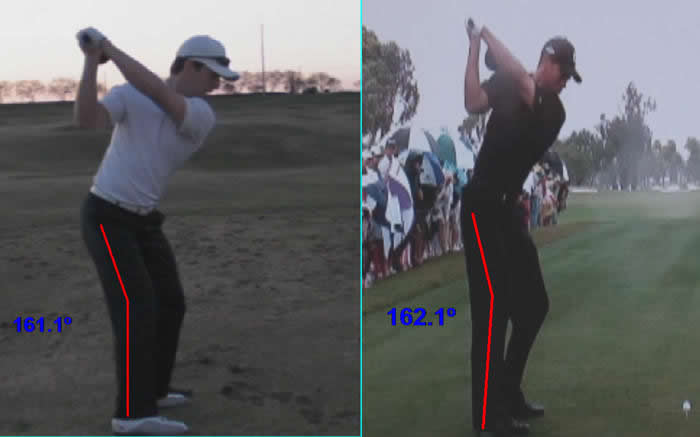
As we start down, this flex in the right knee is maintained or slightly increased. (Note that it appears to increase more than it actually does do to the fact that the rear leg externally rotates somewhat during the backswing.) This is where the dynamic loading of the glutes is really set into motion and fires off the Stretch Shorten Cycle (SSC). Maintaining the knee flex like this rather than spinning the hips around and straightening up gives the arms more time to work back down in front of the body and gets the club working down on the proper path, as well. It also allows the glutes to be engaged during the downswing for power and support. If the right leg straightens early as it does for so many golfers including Josh from the video, the glutes can no longer apply force to the ground which is necessary for power and control.
Without this very powerful motion and knee flex, there is no way someone my size can generate the clubhead speed I do which maxes out in the upper 120's. The big muscles must be used to both support the rotation of the torso and to apply force while using the ground for leverage. If you want to hit the ball further, you MUST use your glutes!
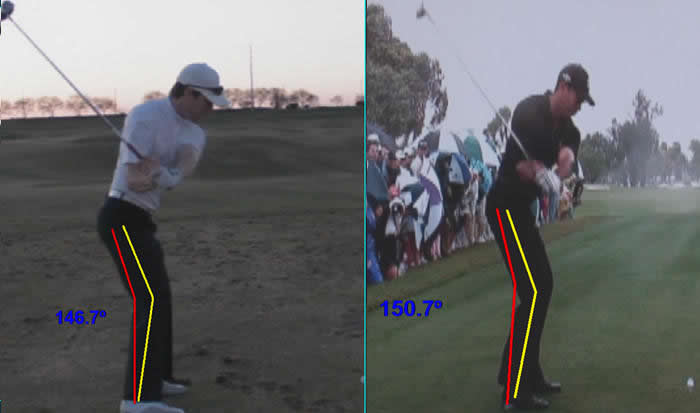
Let's take a look at what happens when the right leg straightens in the downswing, and in this case study, when it is made worse by straightening during the backswing.
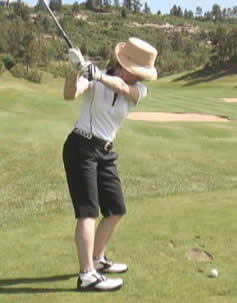
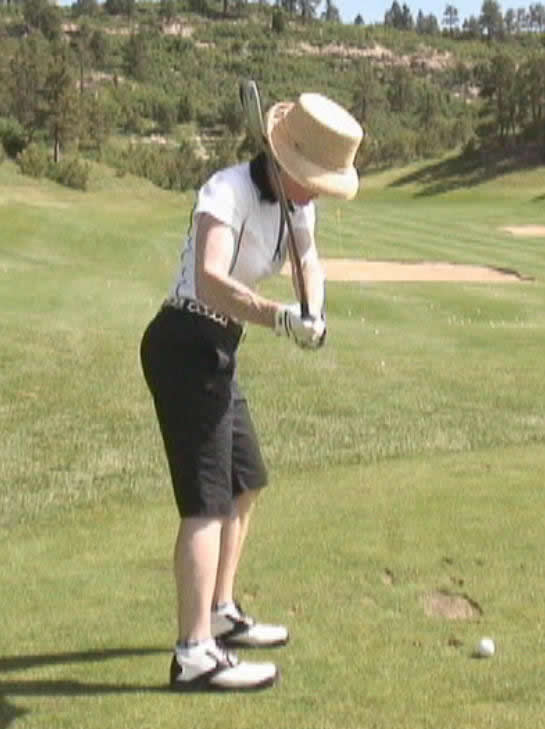
In this example, the golfer has allowed the right leg to completely straighten during the backswing, eliminating the possibility of loading the glutes - the two chunkiest muscles in the body - as they are already near full flexion. To feel this for yourself, stand up and then do a squat. As long as your knees are flexed, you can continue to actively push down into the ground from your glutes. But, once you straighten your knees, you can no longer push and use the ground for leverage using your powerful glute muscles. For most amateurs, this leads to the dreaded over the top move that you can see this golfer performing in the second picture. The shaft should be closer to her right arm than her left at this point. She has nothing left to use but her upper body and this creates a lunge at the ball resulting in a very weak shot.
For better golfers, the problem becomes an issue of the club getting stuck behind them as the come down into impact. This happens because instead of straightening the right leg and then not being able to use it, they keep the leg bent and then use the powerful glutes to spin the hips around ahead of the arms and club. This leads to a path that is too far from the inside and creates blocks and hooks. In both cases, maintaining proper knee flex is the key.
If we bring back the original picture of Tiger Woods, we can now start to see where the payoff is when it comes to power. Again, notice the yellow line I've drawn on his belt in the frame on the left. He's in a tremendously powerful position here, his hips bracing as it he actively works to bring his arms back in front of his body. The glutes are the primary muscles for stabilizing the lower body in the golf swing at impact and are perfectly suited for the job. As he nears impact, notice how much higher his belt is compared to where it was during the transition. This "squat and jump" appearance is Tiger pushing his ankles into the ground during the transition to "anchor" himself to the ground and actively load the glutes by taking advantage of the SSC. As he nears impact, his left glute is pushing hard into the ground to move his body away from the clubhead, further accelerrating the club at the very last instant while stabilizing his lower body against the forces of inertia created by the fast moving clubhead. At impact, note that his right knee, while rotated by his hips toward the target, still maintains its flex.

Teaching golfers this sequence can take weeks but is well worth the effort. But, if you don't have an instructor to help you get this much needed sequence down, we can help! Enter the "Anchor"!
The Anchor Training Aid
The Anchor is the one training aid on the market that helps cure all these ailments in the golf swing and does so not as a gimmicky training aid, but from a pure biomechanics perspective. Developed by Boston Celtics orthopedic surgeon Dr. Brian McKeon, a world-renowned orthopedic surgeon and sports medicine expert, this aid can help dramatically transform your downswing and get you into powerful positions like Tiger Woods you only dreamed of before. Of course, like any training aid, understanding "HOW" to move and "WHERE" to move from is the key to its success, and in this video we discuss those very things that will make the "Anchor" an important element in your training to become a great golfer.
The Anchor works by locking the knee at a set angle throughout the entire swing. The angle is adjustable by the user for your build and setup position. Once locked in place, the right knee remains flexed throughout the swing allowing the golfer to actively engage the right glute throughout the swing and not "stand up" during the backswing or downswing. This constant reinforcement works to train the brain through repetition to maintain the flex throughout the swing. It will not let you straighten up during the backswing and won't let you straighten up during the downswing. Instead, by maintaining your flex, you will be able to feel your right glute activate, perhaps for the first time ever in your swing! This new, powerful feeling will transform your swing if struggle with any of the problems mentioned above, and best of all, it can be worn while playing! You can quickly unlock the brace and walk to your next shot, then simply engage the tabs and it's ready to go!
You can the Anchor in action in our latest video - Maintaining Right Knee Flex.
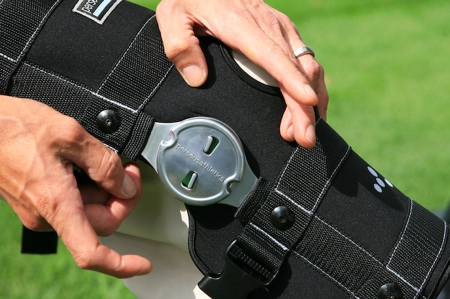 |
Ready to add power back into your golf game?
Pick up your Anchor Training Aid today!
You can purchase the Perseus Anchor today from Rotary Swing Golf for only $129
|
|
You can also discuss the Anchor in our forums here!
|
||||||||

